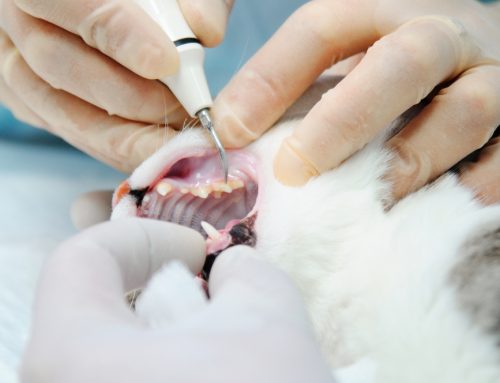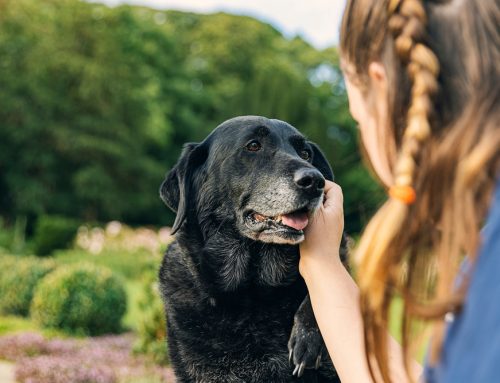Winter is a great time for cozy couch cuddles with your four-legged companions in front of crackling fires. However, like people, pets may develop cabin fever, and you may not be able to resist taking them outside for games of fetch in a winter wonderland. Cold weather can be dangerous for pets, and lead to skin problems and more serious conditions. Our Bolton Veterinary Hospital team reviews four cold weather dangers for pets, with tips to ensure their safety this winter.
#1: Frostbite in pets
Pets, despite their year-round fur coat, are susceptible to frostbite from prolonged exposure to frigid temperatures, especially below 32 degrees. Frostbite, which also affects people, is a painful medical condition that occurs when blood vessels constrict to redirect blood from the extremities to warm and protect the vital organs, including the brain, lungs and heart. Your pet’s tail, nose, ears, and paws are most susceptible to frostbite because of this protective function. Although rarely life-threatening, frostbite is often a precursor to hypothermia, which can be deadly. Frostbite signs include:
- Brittle or shriveled skin that stays cold to the touch
- Skin that is initially pale or bluish-white, and then becomes red and puffy
- Red or gray-tinged skin on the ears, tail, or nose
- Ears, tail, paws, or nose painful to the touch
- Ice crystals in or around the nose
If your pet has frostbite signs, immediately bring them inside and cover them with a dry, warm blanket or towel. Then, take your pet for a veterinary exam to check for any long-term effects that may require treatment and medication to control pain or prevent infection.
#2: Hypothermia in pets
A healthy pet’s body temperature ranges from 100 to 102.5 degrees. However, prolonged exposure to cold temperatures, including cold water, can cause hypothermia, a serious medical condition that occurs when their body temperature drops below 100 degrees. Pets with thick fur coats, such as Siberian huskies and Alaskan malamutes, may better tolerate cold weather, but all animals are susceptible to the effects of cold temperatures. Generally, if it’s too cold for you, it’s too cold for your pet, and you should limit time outdoors.
Puppies, kittens, smaller pets, and senior pets are most susceptible to cold weather exposure. Additionally, pets with chronic health problems, such as kidney or heart disease, are at increased risk of developing hypothermia. Signs can range from mild shivering to severe lethargy, depending on the duration of cold exposure and any underlying health conditions. Monitor your pet for the following hypothermia signs:
- Rectal temperature below 98 degrees
- Shivering
- Lethargy
- Shallow or labored breathing
- Low heart rate
- Dilated pupils
- Pale or bluish skin
- Decreased appetite
Bring your pet inside immediately if you notice any hypothermia signs, cover them with a warm, dry towel or blanket, and call our veterinary team. Your pet may require an overnight hospital stay to safely warm them, and to address any associated illness.
#3: Antifreeze toxicity in pets
Antifreeze, which is used during the colder months to winterize cars and homes, is the culprit for many winter pet emergencies. The active ingredient, ethylene glycol, is a sweet-tasting, odorless liquid that pets find difficult to resist. Small amounts are dangerous—one teaspoon can be lethal to cats, and one to two tablespoons toxic in dogs. Most pets become poisoned when they lick antifreeze that has leaked from a vehicle onto the ground or the garage floor, so ensure you regularly check around your car, and keep pets away from parked vehicles. Cats can also become poisoned if ethylene glycol comes in contact with their skin or paws.
Contact your veterinarian immediately if you know or suspect that your pet has ingested antifreeze, which is rapidly absorbed in the gastrointestinal tract. Initially, your pet will look like a person who drank too much alcohol, but signs will worsen over the next several days as the toxin is absorbed and metabolized through the kidneys and liver. Antifreeze toxicity signs in pets may include:
- Wobbly or uncoordinated movement
- Increased heart rate
- Lethargy
- Vomiting and diarrhea
- Dehydration
- Tremors
- Anorexia
- Fainting
- Low body temperature
- Increased thirst and urination
- Excess salivation
- Seizures
- Mouth ulcers or sores
- Coma
#4: Cracked paws and dry skin in pets

Exposure to cold, dry air, as well as repeatedly coming and going from a warm home to frigid outdoor weather, can lead to chapped, cracked paws and flaky, itchy skin in pets. However, do not bathe your pet often, to preserve their natural oils that support healthy skin and hair coat. Limit your pet’s time outside when it’s cold. Consider dressing them in a warm, well-fitted sweater or jacket, and protecting their paws from injury on cold, wet, or snowy surfaces with snug fitting booties or salves such as Musher’s Secret. After being outside, always dry your pet’s body, paying special attention to their underbelly and between their toes, and removing any ice, snow, salt, or chemicals.
Our Bolton Veterinary Hospital team wants to ensure your pets are safe this winter. Contact our office if you have any questions about protecting your pet from cold weather dangers, or to schedule an appointment if you are concerned they have been exposed to winter toxins or extremely cold temperatures.







Leave A Comment